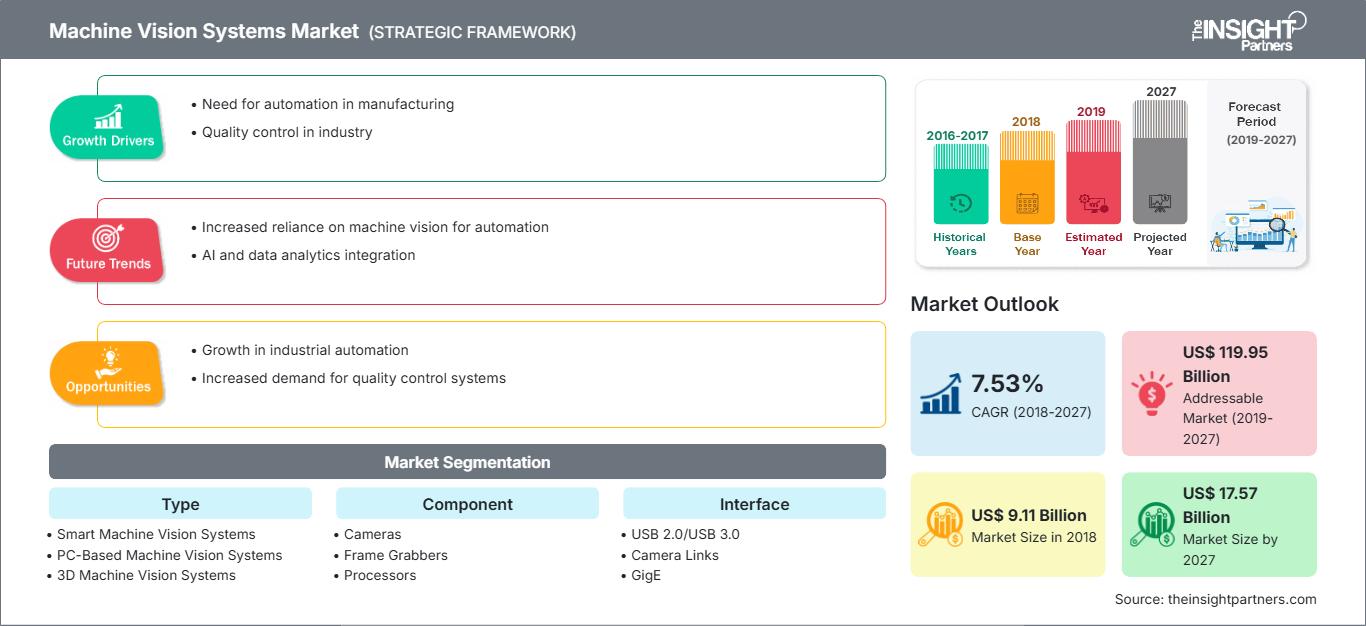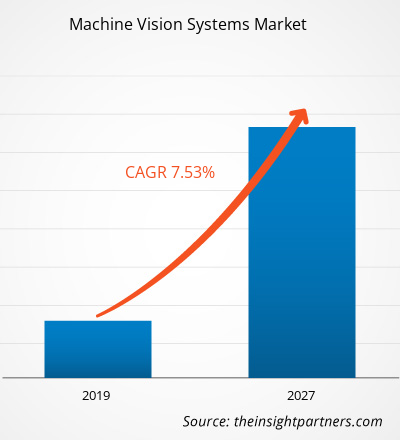Il mercato dei sistemi di visione artificiale è stato valutato a 20,37 miliardi di dollari nel 2025 e si prevede che raggiungerà i 53,40 miliardi di dollari entro il 2034, registrando un CAGR del 12,80% nel periodo 2026-2034.
Analisi di mercato dei sistemi di visione artificiale
Il mercato dei sistemi di visione artificiale è destinato a crescere, trainato dalla crescente automazione in ambito industriale, dalla crescente domanda di ispezione e misurazione visiva e dalla necessità di una maggiore efficienza operativa. Questi sistemi, composti da telecamere, software, ottiche e sensori, consentono attività di rilevamento, identificazione, misurazione e ispezione in tutti i settori manifatturieri e affini. La crescente attenzione alla robotica, all'integrazione con l'Industria 4.0 e ai sistemi di visione guidata alimenta ulteriormente l'espansione del mercato.
Panoramica del mercato dei sistemi di visione artificiale
I sistemi di visione artificiale (MVS) sono soluzioni di automazione intelligenti che utilizzano telecamere, illuminazione, ottiche e algoritmi di elaborazione per replicare le attività di visione umana nelle operazioni industriali. Questi sistemi semplificano le operazioni automatizzando le ispezioni, guidando i robot, consentendo attività di misurazione e verifica e riducendo la dipendenza dal lavoro manuale. Le soluzioni MVS stanno diventando essenziali nei settori manifatturiero, automobilistico, elettronico e in altri settori per aumentare la produttività, la precisione e la conformità agli standard di qualità.
Personalizza questo report in base alle tue esigenze
Riceverai la personalizzazione gratuita di qualsiasi report, incluse parti di questo report, analisi a livello nazionale, pacchetto dati Excel e potrai usufruire di fantastiche offerte e sconti per start-up e università.
Mercato dei sistemi di visione artificiale: approfondimenti strategici

-
Scopri le principali tendenze di mercato di questo rapporto.Questo campione GRATUITO includerà analisi dei dati, che spaziano dalle tendenze di mercato alle stime e alle previsioni.
Driver e opportunità del mercato dei sistemi di visione artificiale
Fattori trainanti del mercato:
- Crescente necessità di ispezioni di prodotti di alta qualità e cicli di produzione più rapidi nel settore manifatturiero.
- Crescente adozione della robotica e dell'automazione guidata dalla visione in settori quali l'automotive e l'elettronica.
- Iniziative e investimenti governativi a sostegno delle fabbriche intelligenti, dell'automazione e della digitalizzazione industriale.
Opportunità di mercato:
- Espansione nei mercati emergenti in cui l'automazione industriale sta prendendo piede, ad esempio nelle regioni Asia-Pacifico.
- Integrazione di analisi in tempo reale, apprendimento automatico e sistemi di visione 3D per consentire ispezioni e applicazioni robotiche più complesse.
Analisi della segmentazione del mercato dei sistemi di visione artificiale
Per tipo:
- Sistemi di visione artificiale intelligenti
- Sistemi di visione artificiale basati su PC
- Sistemi di visione artificiale 3D
Per componente:
- Telecamere
- Frame Grabber
- Processori
- Illuminazioni e Ottica
- Software di visione
- Sensori di visione e altri
Per interfaccia:
- USB 2.0 / USB 3.0
- Collegamento alla fotocamera
- GigE
- CoaXPress
Per settore di utilizzo finale:
- Automobilistico
- Elettronica e semiconduttori
- Cibo e bevande
- Prodotti farmaceutici
- Logistica
Per geografia:
- America del Nord
- Europa
- Asia Pacifico
- America meridionale e centrale
- Medio Oriente e Africa
Approfondimenti regionali sul mercato dei sistemi di visione artificiale
Le tendenze e i fattori regionali che hanno influenzato il mercato dei sistemi di visione artificiale durante il periodo di previsione sono stati ampiamente spiegati dagli analisti di The Insight Partners. Questa sezione illustra anche i segmenti di mercato e la distribuzione geografica dei sistemi di visione artificiale in Nord America, Europa, Asia-Pacifico, Medio Oriente e Africa, America meridionale e centrale.
Ambito del rapporto di mercato sui sistemi di visione artificiale
| Attributo del report | Dettagli |
|---|---|
| Dimensioni del mercato nel 2025 | 20,37 miliardi di dollari USA |
| Dimensioni del mercato entro il 2034 | 53,40 miliardi di dollari USA |
| CAGR globale (2026 - 2034) | 12,80% |
| Dati storici | 2021-2024 |
| Periodo di previsione | 2026-2034 |
| Segmenti coperti |
Per tipo
|
| Regioni e paesi coperti |
America del Nord
|
| Leader di mercato e profili aziendali chiave |
|
Densità degli operatori del mercato dei sistemi di visione artificiale: comprendere il suo impatto sulle dinamiche aziendali
Il mercato dei sistemi di visione artificiale è in rapida crescita, trainato dalla crescente domanda degli utenti finali, dovuta a fattori quali l'evoluzione delle preferenze dei consumatori, i progressi tecnologici e una maggiore consapevolezza dei vantaggi dei prodotti. Con l'aumento della domanda, le aziende stanno ampliando la propria offerta, innovando per soddisfare le esigenze dei consumatori e sfruttando le tendenze emergenti, alimentando ulteriormente la crescita del mercato.

- Ottieni una panoramica dei principali attori del mercato dei sistemi di visione artificiale
Analisi della quota di mercato dei sistemi di visione artificiale per area geografica
America del Nord
- Detiene una quota significativa grazie alle infrastrutture di produzione avanzate, all'adozione precoce dell'automazione e ai sistemi di visione.
- Tendenze: crescente utilizzo della robotica guidata dalla visione e delle telecamere intelligenti nei settori automobilistico ed elettronico.
Europa
- Forte spinta da parte del settore pubblico e privato verso l'automazione industriale e il rispetto degli standard nei settori automobilistico ed elettronico.
- Tendenze: adozione di sistemi di visione interoperabili e ottimizzazione della produzione transfrontaliera.
Asia Pacifico
- La regione in più rapida crescita è dovuta all'espansione delle basi produttive, alla crescente automazione industriale e ai maggiori investimenti nei sistemi di visione.
- Tendenze: rapida adozione in Cina, India e nel Sud-est asiatico per l'ispezione, la produzione di componenti elettronici, il confezionamento e l'industria automobilistica.
America meridionale e centrale
- Mercato emergente con crescente domanda di sistemi di ispezione visiva e automazione di fabbrica convenienti.
- Tendenze: i produttori di piccole e medie dimensioni adottano sistemi di visione modulari per il controllo qualità.
Medio Oriente e Africa
- Regione in via di sviluppo con investimenti infrastrutturali e crescente automazione nei settori manifatturiero, petrolifero e del gas e della logistica.
- Tendenze: adozione di sistemi di ispezione e robotica basati sulla visione nei nuovi centri di produzione.
Densità degli operatori del mercato dei sistemi di visione artificiale: comprendere il suo impatto sulle dinamiche aziendali
Il mercato dei sistemi di visione artificiale è caratterizzato sia da grandi aziende globali che da numerosi specialisti regionali, il che lo rende moderatamente competitivo e ad alta intensità tecnologica. I principali fornitori si differenziano per:
- Integrazione avanzata di moduli di visione 3D, intelligenza artificiale e telecamere intelligenti.
- Soluzioni scalabili adatte sia ai piccoli che ai grandi produttori.
- Partnership con fornitori di robotica, automazione e software per offrire soluzioni end-to-end basate sulla visione.
Le principali aziende che operano nel mercato dei sistemi di visione artificiale includono:
- Basler AG
- Cognex Corporation
- DataLogic SpA
- FLIR Systems, Inc.
- IDS Imaging Development Systems GmbH
- ISRA VISION AG
- Keyence Corporation
- OmniVision Technologies, Inc.
- Omron Microscan Systems, Inc.
- Toshiba Teli Corporation
Altre aziende analizzate nel corso della ricerca:
- Microscan Systems, Inc.
- National Instruments Corporation
- Sony Corporation
- Teledyne Technologies Incorporated
- Allied Vision Technologies GmbH
- JAI A/S
- SICK AG
- Baumer Holding AG
- Vision Components GmbH
- Tordivel AS
Notizie di mercato e sviluppi recenti sui sistemi di visione artificiale
- Un comunicato stampa conferma che si prevede che il mercato dei sistemi di visione artificiale raggiungerà i 17,57 miliardi di dollari entro il 2027 (anno di base 2018).
- Il mercato ha registrato forti prospettive di crescita per i sistemi di visione artificiale intelligenti e per i sistemi di visione artificiale 3D, sempre più adottati nei settori automobilistico, dell'elettronica e dei semiconduttori e della logistica.
- I principali attori stanno ampliando le proprie capacità tramite l'intelligenza artificiale, l'imaging 3D e le partnership con i produttori di robotica per migliorare le attività di ispezione e automazione.
Copertura e risultati del rapporto sul mercato dei sistemi di visione artificiale
Il rapporto "Machine Vision Systems Market – Global Analysis & Forecasts (2021–2034)" di The Insight Partners fornisce:
- Dimensioni e previsioni del mercato a livello globale, regionale e nazionale in tutti i segmenti chiave coperti dall'ambito.
- Tendenze e dinamiche del mercato, quali fattori trainanti, vincoli e opportunità.
- Analisi PEST e SWOT dettagliate.
- Analisi che copre le principali tendenze del mercato, il quadro normativo, i principali attori e gli sviluppi recenti.
- Analisi del panorama industriale e della concorrenza, tra cui concentrazione del mercato, analisi delle mappe di calore, attori principali e sviluppi recenti.
- Profili aziendali dettagliati dei principali attori.
- Analisi storica (2 anni), anno base, previsione (7 anni) con CAGR
- Analisi PEST e SWOT
- Valore/volume delle dimensioni del mercato - Globale, Regionale, Nazionale
- Industria e panorama competitivo
- Set di dati Excel
Report recenti
Testimonianze
Motivo dell'acquisto
- Processo decisionale informato
- Comprensione delle dinamiche di mercato
- Analisi competitiva
- Analisi dei clienti
- Previsioni di mercato
- Mitigazione del rischio
- Pianificazione strategica
- Giustificazione degli investimenti
- Identificazione dei mercati emergenti
- Miglioramento delle strategie di marketing
- Aumento dell'efficienza operativa
- Allineamento alle tendenze normative






















 Ottieni un campione gratuito per - Mercato dei sistemi di visione artificiale
Ottieni un campione gratuito per - Mercato dei sistemi di visione artificiale